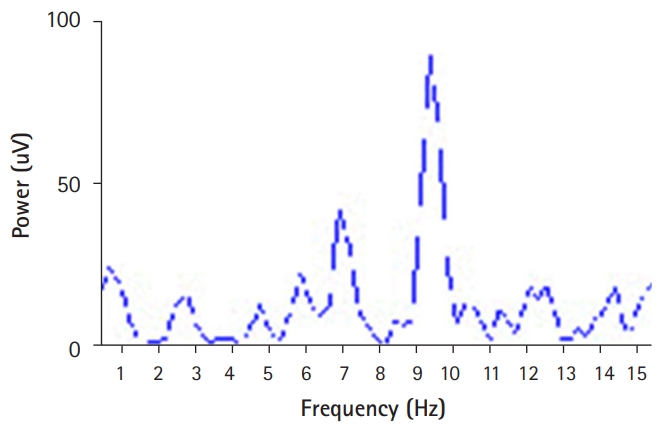 |
 |
- Search
| Ann Child Neurol > Volume 28(1); 2020 > Article |
|
Orolingual tremor is a rhythmic, involuntary movement of the jaw, tongue, pharynx, or lower face [1]. It is often described in ParkinsonŌĆÖs disease and can be seen in patients with severe essential tremor. Some medications, especially neuroleptics, have been reported to cause orolingual tremors. Orolingual tremors can be classified as resting tremors or activation-induced tremors. Activation-induced tremors include positional and task-specific tremors. Task-specific tremors are defined as no tremor at rest, but occurs exclusively during a specific task including speaking, whistling, smiling, or playing wind instruments. Task-specific orolingual tremors induced by smiling is a rare phenomenon. So far, only two adult case series of facial tremor occurring on smiling have been described in the literature [2,3]. Orolingual tremor on smiling in children has not been reported yet. We report a child who present with orolingual tremor only on smiling due to activation of the risorius muscles.
This study was approved by the Institutional Review Board of Seoul National University Bundang Hospital (IRB No. B-1905-540-701). Informed consent was waived by the board. A 16-year-old boy was referred with orolingual tremor induced by smiling. He had this symptom for few years. Recently, the frequency of tremor increased and his friends often mentioned about his facial tremor. He previously had a prolonged course of topical steroid therapy prescribed for atopic dermatitis. He has not exposed to any neuroleptics prior to the onset of tremor. There was no postural limb tremor, no family history. On neurologic examination, orolingual tremor was not detected at rest. Saying ŌĆśa,ŌĆÖ ŌĆśe,ŌĆÖ or tongue protrusion did not induce tremor. Bilateral arrhythmic tremor around the lip was induced exclusively on smiling. The reminder of his neurologic examination was normal. A brain magnetic resonance imaging excluded any brain parenchymal pathology. All blood tests including complete blood count, chemistry, electrolytes, thyroid function test, magnesium, ionized calcium were normal. We performed needle electromyogram (EMG) recording from the orbicularis orii and risorius muscles. Needle EMG activity was recorded at rest and smiling. Patient had normal EMG recording at rest without myokymic discharges. EMG during smiling revealed approximately 9 to 10 Hz bursts of 76 ms duration in the risorius muscles associated with visible bilateral tremors (Fig. 1). His tremor on smiling did not responded to propranolol.
We described a child with orolingual tremor exclusively induced by smiling due to activation of the risorius muscles. This child had no evidence of orolingual dystonia, essential tremor, or associated neurological disorders. This tremor on smiling is a rare disease entity. It did not occur at rest, nor associated with dystonia. This is one of the task-specific orolingual tremors which occur exclusively during specific postures or tasks. Task-specific orolingual tremor induced by drinking or by positioning oneŌĆÖs teeth close together have been reported [4]. Jacome and Yanez [2] described the first case of a 27-year-old woman who presented with perioral facial tremor induced by smiling. She had no underlying neurologic disease, but family history of facial tremor. Hence, facing tremor was suggested as a form of familial essential tremor. Furthermore, Schwingenschuh et al. [3] described two adult cases with orolingual tremor induced by smiling. One patient had young-onset ParkinsonŌĆÖs disease, whereas the other had no neurological disorders. Orolingual tremor had a frequency of 9 Hz and EMG burst duration were 70 to 85 ms. Our case also has a similar tremor peak frequency of 9 to 10 Hz and burst duration of 76 ms. Only smiling due to the activation of risorius muscles induced bilateral irregular arrhythmic tremor around the lip. Cause of tremor on smiling is uncertain, but it may be a discrete entity rather than a form of familial essential tremor or an early symptom of ParkinsonŌĆÖs disease. The incidence of task-specific orolingual tremor is low in children, but should be recognized and described by physician.
Notes
Author contributions
Conceptualization: SAC and HH. Data curation: SAC. Writing-original draft: SAC. Writing-review & editing: JY and HK.
- TOOLS








